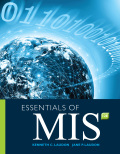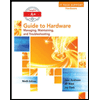
EBK ESSENTIALS OF MIS
12th Edition
ISBN: 8220101459305
Author: LAUDON
Publisher: PEARSON
expand_more
expand_more
format_list_bulleted
Expert Solution & Answer
Chapter 7, Problem 1RQ
Explanation of Solution
Features of simple network:
- The client computers, server computer, network
operating system software, network interfaces, hub, and a connection medium are the entities of a simple network. - The basic responsible for network operating system software is controlling the network and its functions.
- One client computer is connected to another client computer within the same network.
- Hubs and switches function is sending packets of data to all other linked devices.
- The network helping up web pages to storing data and network operating system.
- The switch has the capability to select a particular destination while the hub sends a packet to all other linked devices.
- The network components links with the connection mediums such as coaxial cables, radio signals or telephone wires.
- The Microsoft Window Server, Linux and Novell Open Enterprise Server are the most commonly used network operating system software.
Features of the Network Infrastructure for a large company:
- The large companies have many employees and several locations, the collection of hundreds of small LANs needs to be joined into a corporate-wide networking infrastructure.
- The infrastructure also has the capability to support mobile sales by using mobile employees connecting to the company website, smartphones, interior company networks using Wi-Fi networks and videoconferencing systems to provide efficient communication between managers on a global scale.
- The infrastructure is included many small LANs that are connected to other LANs and to corporate networks.
- Overall, the large company network infrastructure includes the use of a wide variety of technologies like corporate data networks to internet service, ordinary telephone service, wireless internet and cell phones.
Explanation of Solution
Principal technologies and trends:
- Client/ Server computing
- Packet switching
- TCP/ IP and Connectivity
Client/ Server computing:
- Client/ Server computing is defined as a distributed computing model where a part of the processing power is placed within cheap client computers and exist in laptops, handled devices or desktops.
- It also allows for computing to departments, factory floors, workgroups and other parts of a business that couldn’t be worked by a centralized architecture.
- The clients are linked to other clients through networks that is controlled by a network server computer.
- It has replaced by centralized mainframe computer.
- The process of the client/ server computing has no longer take place on a central large mainframe computer.
Packet Switching:
- Messages transferring in the internet are divide into fixed size unit of data called packet.
- Messages are divided into packets to increase the performance and reliability of the internet.
- Ιt also improves the effectiveness of the communication line in the internet.
- Packets travel through several routers before it reaches the destination.
- Router is a device that provides a path for the packet to reach the destination.
- If there is a failure in one path, the router will provide an alternative route.
- Packets are directed based on the destination address present within each packet.
- Packets reach the destination in the different order. So, it is collected and rearranged in the destination to get the original message, referred to as packet switching.
TCP/IP (Transmission Control Protocol/Internet protocol) and Connectivity:
- TCP (Transmission Control Protocol)/IP (Internet Protocol) is a protocol suite used to connect the host from the different networks.
- It is a protocol stacked with five layers. They are physical layer, data link layer, network layer, transport layer, and application layer.
- In TCP/IP, the lower layer protocols supports higher layer protocols.
- TCP/IP also supports low-level communication.
- TCP can integrate with IP to provide additional functionalities such as failure recovery, optimize data transmission etc.
- TCP is located at the transport layer and IP (Internet Protocol) is located at the network layer.
- TCP is responsible for dividing the message into one or more packets in source and reassemble the packet in destination.
- IP is responsible for transmitting of packets from source to destination.
Want to see more full solutions like this?
Subscribe now to access step-by-step solutions to millions of textbook problems written by subject matter experts!
Students have asked these similar questions
7. Long-Distance CallsA long-distance provider charges the following rates for telephone calls:
Rate Category Rate per MinuteDaytime (6:00 a.m. through 5:59 p.m.) $0.07Evening (6:00 p.m. through 11:59 p.m.) $0.12Off-Peak (midnight through 5:59 a.m.) $0.05Write a GUI application that allows the user to select a rate category (from a set of radio buttons), and enter the number of minutes of the call into an Entry widget. An info dialog box should display the charge for the call.
Name and Address
The Name and Address Problem
Write a GUI program that displays your name and address when a button is clicked. The program’s window should appear as the sketch on the left side of Figure 13-61 when it runs. When the user clicks the Show Info button, the program should display your name and address, as shown in the sketch on the right of the figure.
Exercise 1 Function and Structure [30 pts]
Please debug the following program and answer the following questions. There is a cycle in a linked
list if some node in the list can be reached again by continuously following the next pointer.
#include
typedef struct node {
int value;
struct node *next;
} node;
int 11_has_cycle (node *first)
if (first
==
node *head =
{
NULL) return 0;
first;
while (head->next != NULL) {
}
if (head
first) {
return 1; }
head = head->next;
return 0;
void test ll_has_cycle () {
int i;
node nodes [6];
for (i = 0; i < 6; i++) {
nodes [i] .next = NULL;
nodes [i].value = i;
}
nodes [0] .next
=
&nodes [1];
nodes [1] .next
=
&nodes [2];
nodes [2] .next
=
&nodes [3];
nodes [3] .next
nodes [4] .next
&nodes [4];
NULL;
nodes [5] .next = &nodes [0];
printf("1. Checking first list for cycles. \n Function 11_has_cycle says it
has s cycle\n\n", 11_has_cycle (&nodes [0])?"a":"no");
printf("2. Checking length-zero list for cycles. \n Function 11_has_cycle
says it has %s…
Knowledge Booster
Similar questions
- how to read log logsarrow_forwardDiscrete Mathematics for Computer Engineeringarrow_forwardQuestion 1 - Array Iterators Like the JS on A2, there is no visual component to this question. The HTML really just needs to load the JavaScript, everything else will output to the console. The JS file should the completion of the task, and all necessary testing, so that just loading the file will complete the task with enough different inputs to ensure it works. Even Numbers [3 marks] Create a function that determines if a provided number is even. Define an array of numbers, then on the array use the appropriate array iterator to determine if the array contains only even numbers using the function you defined. Output the results, and test with several arrays. Long Names [3 marks] Define an array of names. Use an iterator to retrieve a new array containing only the names longer then 12 characters. Your iterator should be passed an anonymous arrow function. Test with several different arrays First Names [3 marks] Define an array called fullNames that contains 7 javascript objects of…arrow_forward
- Discrete Mathematics for Computer Engineeringarrow_forwardthis module is java 731 . make sure my answers are 1005 correct and the layout and structure is perfect and also include all comments etc. thank you i have attached question 1 (40 marks) and question 2 (30 marks ) this is question 3: Question3: (30 MARKS) Passenger Rail Agency for South Africa Train Scheduling System Problem Statement Design and implement a train scheduling system for Prasa railway network. The system should handle the following functionalities: 1. Scheduling trains: Allow the addition of train schedules, ensuring that no two trains use the same platform at the same time at any station. 2. Dynamic updates: Enable adding new train schedules and canceling existing ones. 3. Real-time simulation: Use multithreading to simulate the operation of trains (e.g., arriving, departing). 4. Data management: Use ArrayList to manage train schedules and…arrow_forwardthis module is java 731 . make sure my answers are 1005 correct and the layout and structure is perfect and also include all comments etc. thank you i have attached question 1 (40 marks) and question 2 (30 marks ) this is question 3: Question3: (30 MARKS) Passenger Rail Agency for South Africa Train Scheduling System Problem Statement Design and implement a train scheduling system for Prasa railway network. The system should handle the following functionalities: 1. Scheduling trains: Allow the addition of train schedules, ensuring that no two trains use the same platform at the same time at any station. 2. Dynamic updates: Enable adding new train schedules and canceling existing ones. 3. Real-time simulation: Use multithreading to simulate the operation of trains (e.g., arriving, departing). 4. Data management: Use ArrayList to manage train schedules and…arrow_forward
- this module is java 731 . make sure my answers are 1005 correct and the layout and structure is perfect and also include all comments etc. thank you i have attached question 1 (40 marks) and question 2 (30 marks ) this is question 3: Question3: (30 MARKS) Passenger Rail Agency for South Africa Train Scheduling System Problem Statement Design and implement a train scheduling system for Prasa railway network. The system should handle the following functionalities: 1. Scheduling trains: Allow the addition of train schedules, ensuring that no two trains use the same platform at the same time at any station. 2. Dynamic updates: Enable adding new train schedules and canceling existing ones. 3. Real-time simulation: Use multithreading to simulate the operation of trains (e.g., arriving, departing). 4. Data management: Use ArrayList to manage train schedules and…arrow_forwardDiscrete Mathematics for Computer Engineeringarrow_forwardTask 1: Write an abstract class Method +: public -: private #: protected Underline: static # input: int # output:String Method + isHard():boolean + specificWay():String + Method() + Method(input: int, output: String) + getInput(): int + setInput(input: int): void + getOutput(): String + setOutput(output: String): void +toString(): String Question Task 2: Write a class ReadMethod that extends the Method class. +: public -: private #: protected Underline: static -language: String ReadMethod Question + ReadMethod() + ReadMethod(input: int, output: String, language: String) + isHard():boolean + specific Way(): String +toString(): String + getLanguage(): String + setLanguage(language: String): voidarrow_forward
- i have attatched my java question , please make sure it is answered correct, include all comments etc, thank youarrow_forwardi have attached my 2 java questions . please answer them correctly, add all comments etc . thank you.arrow_forwardCan you help me solve this problem using Master's Theorem:Solve the recurrence relation f(n) = 3af(n/a) + (n + a)2 with f(1) = 1 and a > 1 byfinding an expression for f(n) in big-Oh notation.arrow_forward
arrow_back_ios
SEE MORE QUESTIONS
arrow_forward_ios
Recommended textbooks for you
 Fundamentals of Information SystemsComputer ScienceISBN:9781337097536Author:Ralph Stair, George ReynoldsPublisher:Cengage Learning
Fundamentals of Information SystemsComputer ScienceISBN:9781337097536Author:Ralph Stair, George ReynoldsPublisher:Cengage Learning Principles of Information Systems (MindTap Course...Computer ScienceISBN:9781305971776Author:Ralph Stair, George ReynoldsPublisher:Cengage Learning
Principles of Information Systems (MindTap Course...Computer ScienceISBN:9781305971776Author:Ralph Stair, George ReynoldsPublisher:Cengage Learning Principles of Information Systems (MindTap Course...Computer ScienceISBN:9781285867168Author:Ralph Stair, George ReynoldsPublisher:Cengage Learning
Principles of Information Systems (MindTap Course...Computer ScienceISBN:9781285867168Author:Ralph Stair, George ReynoldsPublisher:Cengage Learning Systems ArchitectureComputer ScienceISBN:9781305080195Author:Stephen D. BurdPublisher:Cengage Learning
Systems ArchitectureComputer ScienceISBN:9781305080195Author:Stephen D. BurdPublisher:Cengage Learning A+ Guide to Hardware (Standalone Book) (MindTap C...Computer ScienceISBN:9781305266452Author:Jean AndrewsPublisher:Cengage Learning
A+ Guide to Hardware (Standalone Book) (MindTap C...Computer ScienceISBN:9781305266452Author:Jean AndrewsPublisher:Cengage Learning


Fundamentals of Information Systems
Computer Science
ISBN:9781337097536
Author:Ralph Stair, George Reynolds
Publisher:Cengage Learning

Principles of Information Systems (MindTap Course...
Computer Science
ISBN:9781305971776
Author:Ralph Stair, George Reynolds
Publisher:Cengage Learning

Principles of Information Systems (MindTap Course...
Computer Science
ISBN:9781285867168
Author:Ralph Stair, George Reynolds
Publisher:Cengage Learning

Systems Architecture
Computer Science
ISBN:9781305080195
Author:Stephen D. Burd
Publisher:Cengage Learning

A+ Guide to Hardware (Standalone Book) (MindTap C...
Computer Science
ISBN:9781305266452
Author:Jean Andrews
Publisher:Cengage Learning